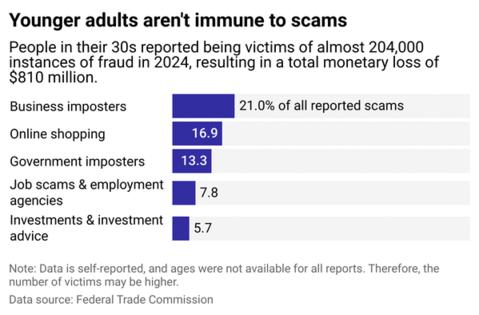5 investment scams millennials fall for and how to avoid them
Published in Slideshow World
Subscribe
5 investment scams millennials fall for and how to avoid them
Age is just a number, particularly for online criminals. Scammers don't care how old someone is—if they can dupe someone into giving them money, that's all that matters.
While always a problem, the proliferation of online scams exploded during the COVID-19 pandemic. Between 2019 and 2020, scam complaints to the FBI increased by 69% to nearly 792,000, according to the FBI's 2023 Internet Crime Report. Losses increased 20% to $4.2 billion. Criminals have continued to up their game ever since. In 2023, the most current year available, complaints exceeded 880,000, with losses skyrocketing to $12.5 billion. CheapInsurance.com used data from the FBI's 2023 Internet Crime Report to analyze the scams that frequently target millennials.
The general perception of online fraud victims is that they're older people who aren't technologically savvy, making them prime targets for scammers. However, as online criminals have become more sophisticated, that belief has become outdated.
In 2023, the FBI's Internet Crime Complaint Center tracked over 101,000 scam complaints from people 60 or older that resulted in $3.4 billion in losses, but the 30-to-49 demographic reported more complaints—over 172,000—for $2.7 billion in losses.
People may equate susceptibility to scams to older adults because they lose more money than other generations. Compared with a median loss of $450 to $500 for those ages 30 to 49, those ages 60 to 69 had a median loss of $691, per 2024 data from the Federal Trade Commission. Those losses escalated with age—those 80 and over lost over twice as much as their younger counterparts, with a median loss of $1,650.
Although their financial losses weren't as high, millennials were as susceptible to scams, according to the FTC. About 1 in 3 people ages 30 to 49 reported frauds and losses in 2024, about the same likelihood as those 60 or older.
It's hard to imagine that millennials, who have spent most of their lives online, would fall for financial scams, but criminals have learned to shift their focus from phone-based scams to online, social media, and text scams. According to the Pew Research Center, millennials trust information on social media more than their older counterparts—about 40% compared with about 20%—so they are more vulnerable on these platforms.
Of course, everyone is human. Even savvy tech users can fall for a social media ad proclaiming a too-good-to-be-true sale on their favorite brand of shoes, respond to a bogus text about their bank account having issues, or pay someone online to "buy" bogus cryptocurrency. Cybersecurity expert Bruce Schneier told The Harvard Gazette that scammers have become relentless in finding victims. If they find someone having a bad day, they can easily exploit that weakness.
Visit thestacker.com for similar lists and stories.
People in their 30s fall victim to business imposters
Criminals have more touchpoints to exploit as people conduct more of their lives online. Online accounts, bill pay, and peer-to-peer money transfers simplify daily transactions, but fraudsters have proved to be particularly adept at exploiting these relationships. They pretend to be a legitimate business or a government entity like the IRS and text or send direct messages about issues with an account, potential prize money, or a missing payment that an individual can easily resolve by clicking a link. Unfortunately, the link is fraudulent and designed to get account information or payments.
In early 2025, scammers bombarded phones with unsolicited texts about unpaid tolls and E-ZPass bills. The FBI told NBC it had received over 60,000 complaints about this scam.
Scammers imitate trusted sources
Government impersonation scams are becoming increasingly profitable for criminals, who ask victims to urgently pay cash to fix a "problem" like losing Social Security benefits or owing taxes to the IRS. They go to extensive lengths to build a story to get victims to part with hard-earned money, and even the savviest people get duped.
In 2023, personal finance reporter Charlotte Cowles fell victim to an Amazon scam claiming that someone had hacked her account. She eventually lost $50,000 to people impersonating the FTC and the CIA.
She's not alone. The FTC reported $76 million in consumer losses to government imposters in 2023, almost doubling 2022's $40 million in losses.
Online shopping scams surge
Most people shop online, but scammers also exploit those transactions, particularly around the holidays, when people shop more. In 2024, the second most reported type of fraud came from online shopping scams, including texts or emails about unexpected packages or changes in travel plans that require clicking on a spoofed link.
Some online shopping scams start as social media ads for massive sales that dupe people into buying merchandise that never arrives because it never existed. Social media platforms generally don't screen to see whether an advertiser is legitimate because it's not in their best interest to do so. Schneier told The Harvard Gazette, "They don't do a good job because fake ads generate the same revenue as real ads. Why should they screen it? It's profitable."
Job and investment fraud on the rise
Job hunters are also easy targets. In 2024, people lost $501 million to job and employment agency scams, a nearly 457% increase from 2020, per a 2025 FTC report. Popular scams include work-from-home schemes that offer much higher pay but may involve purchasing a starter kit, scams involving reshipping or reselling merchandise, paying for recruitment services, or paying for a federal job.
The rise of cryptocurrency has fueled more investment fraud. Scammers will offer tremendous returns on crypto purchases. They encourage individuals to invest on platforms that show growth so victims invest more in crypto—except the platforms were never real. Many criminals also demand up-front payment in cryptocurrency. Because crypto payments don't have legal protections and typically aren't reversible, one small mistake can send thousands of dollars into a scammer's account.
Other scams targeting digitally savvy adults to watch out for
Why is it so easy to lose hard-earned money? Criminals go to great lengths to illegitimately build their wealth. They target homebuyers by impersonating sellers, creating fake real estate listings, and intercepting title payments before closing. CertifID's 2025 State of Wire Fraud report found that scammers targeted 1 in 4 homebuyers and sellers and were successful every 20 tries.
Millennials who have grown up online and rely on social media every day can be prone to social media hacking. This can result in identity theft or profile "spoofing"—creating a fake account that impersonates a real person—to exploit friend and follower lists.
Scammers know how to push the right psychological buttons on their victims. Many scams have a sense of urgency, tapping into people's fear of missing out through limited offers or exclusive deals. Romantic scams play on people's loneliness and create an emotional bond before scammers help victims invest in cryptocurrency—and take their money in the process.
Many millennials face financial pressure due to student loan debt, making them more prone to scam promises for debt relief. These scams may require up-front payment for services that never materialize or make false promises about debt relief.
Criminals also know how to use just enough information to sound legitimate. For Cowles, hearing scammers discuss details like the last four digits of her Social Security number lured her further into their deceit.
While criminals are experts in bilking increasingly younger people out of money, millennials can leverage their digital know-how to protect themselves from becoming scam victims. Being aware of current fraudulent schemes and second-guessing products that seem too good to be true can go a long way to preventing financial ruin at the hands of a scammer.
Story editing by Carren Jao. Copy editing by Yvonne Ngai-Fodge.
This story originally appeared on CheapInsurance.com and was produced and distributed in partnership with Stacker Studio.









Comments